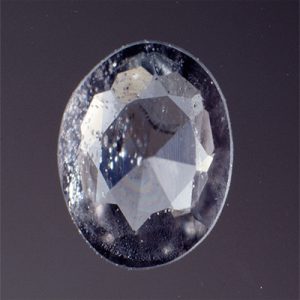Musgravite
Musgravite is one of the rarest of all gem species. Tested and certified faceted Musgravites are exceptionally rare. Musgravite is closely related to Taaffeite and the separation between the two is based on magnesium content. It is very difficult to distinguish Musgravite from Taaffeite. Their physical and optical properties are almost identical and the only sure way of determining one from the other is by Raman Spectroscopy. Musgravite and Taaffeite are two of the hardest of the extremely rare gem species with a hardness of 8.0 – 8.5 on the Moh’s scale.
Musgravite was recently renamed by the IMA (International Mineralogical Association) and is now officially known asMagnesiotaaffeite-6N’3S. Musgravite was originally named after the Musgrave Ranges of Southern Australia where it was first discovered but has been renamed Magnesiotaaffeite-6N’3S by the IMA for its association with Taaffeite and its magnesium content. Musgravite was renamed as a method of clarifying the complexity of the compositions of Taaffeite Group minerals including Musgravite, Perhmanite and Taaffeite and the influences of the minerals Spinel and Nolanite on them.
So, according to the new nomenclature accepted by the IMA, Musgravite has become Magnesiotaaffeite-6N’3S, as it is composed of six modified Nolanite modules (6N) and three Spinel modules (3S). Correspondingly, Taaffeite has become Magnesiotaaffeite-2N’2S and Perhmanite has become Ferrotaaffeite-6N’3S. Taaffeite is now an IMA approved name for the group of minerals containing Musgravite (Magnesiotaaffeite-6N’3S), Perhmanite (Ferrotaaffeite-6N’3S) and Taaffeite (Magnesiotaaffeite-2N’2S). The names Musgravite and Taaffeite have been relegated to trade name status. However, I suspect that these names will continue to be used in the gem trade as the individual gem names.
Musgravite has been found at the Type Locality 16 km north-northeast of Ernabella Mission, Musgrave Ranges, South Australia; along Casey Bay, Enderby Land, Antarctica and at Dove Bugt, northeast Greenland. The only sources of facetable crystals are at Tunduru, Tanzania and a very limited find in 2009 at Mogok, Burma.
| Chemical Formula: | (Mg,Fe2+,Zn)2Al6BeO12 |
| Magnesium Iron Zinc Aluminum Beryllium Oxide | |
| Molecular Weight: | 426.60 gm |
| Composition: | Magnesium | 9.69 % | Mg | 16.06 % | MgO |
| Beryllium | 1.90 % | Be | 5.28 % | BeO | |
| Aluminum | 37.95 % | Al | 71.70 % | Al2O3 | |
| Zinc | 1.53 % | Zn | 1.91 % | ZnO | |
| Iron | 3.93 % | Fe | 5.05 % | FeO | |
| Oxygen | 45.00 % | O | |||
| 100.00 % | 100.00 % | = TOTAL OXIDE |
| Crystallography: | Trigonal – Hexagonal Scalenohedral |
| Crystal Habit: | Crystals platy on {0001}, to 0.5 mm; massive. |
| Twinning: | None |
| Cleavage: | Perfect on {0001} (or a Parting); less Perfect on {1011} |
| Fracture: | Platy |
| Tenacity: | Brittle |
| Moh’s Hardness: | 8.0 – 8.5 |
| Density: | 3.68 (g/cm3) |
| Luminescence: | None |
| Radioactivity: | Not Radioactive |
| Color: | Light Olive Green, dark Greenish Blue, light to dark Violet; nearly Colorless in thin section |
| Transparency: | Transparent to Translucent |
| Luster: | Vitreous |
| Refractive Index: | 1.719 – 1.739 Uniaxial ( – ) |
| Birefringence: | 0.0070 |
| Dispersion: | n/a |
| Pleochroism: | None |


